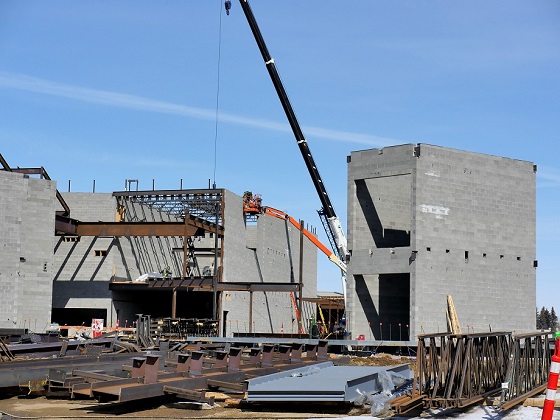Alberta
$8.6 billion committed: Province to fund up to 30 new schools and 8 modernizations in each of next 3 years

Alberta’s government is committing $8.6 billion to complete and open 200,000 new student spaces across the province in the next seven years.
Alberta’s population is growing exponentially as more people from across Canada and around the world choose to make the province their home. This rapid growth is causing strain on the Kindergarten to Grade 12 education system, with student enrolment increasing at historic rates.
To keep up with fast-rising student enrolment, Alberta’s government is committing $8.6 billion through the new School Construction Accelerator Program. This program will create more than 200,000 new and modernized spaces for students to learn, grow and reach their full potential. Starting in Budget 2025, Alberta’s government will kick-start up to 30 new schools and as many as eight modernizations and replacement schools every year for the next three years.
“Every student deserves a quality education in a school that can meet their learning needs and set them on a path to success in the future. As hundreds of thousands of people are choosing to make Alberta their home, we are responding by funding and building the schools our fast-growing communities need. As we build, we’re asking school boards and municipalities to work with us so we can get shovels in the ground as quickly as possible.”
The Calgary Metropolitan Area and Edmonton Metropolitan Region, along with other communities across the province, have been feeling the pressures of strong student growth and aging school infrastructure. The School Construction Accelerator Program will result in 50,000 new or modernized student spaces over the next three years – and more than 150,000 new and modernized spaces over the following four years. In total, the School Construction Accelerator Program will mean approval for up to 30 new school projects and as many as eight new modernization and replacement projects every year over the next three years. In addition to the school projects, 20,000 new student spaces will be delivered through modular classrooms over the next four years.
“We are investing in the future of our province. Through our commitment to kick-start 30 new schools each year over the next three years, we are delivering new student spaces across the province and in our fastest-growing communities for students to learn, grow and reach their full potential.”
“I look forward to working with my ministry and industry partners to build the schools Albertans need and ensuring that each project is as unique as the students who use them. School builds, modernizations and renovations support tens of thousands of jobs across the province. As Alberta communities continue to grow, this announcement will allow us to meet demands for spaces faster and more efficiently, all while creating jobs and boosting our local and provincial economies.”
The School Construction Accelerator program also takes immediate action to speed up the construction of schools by enabling school projects to be approved in-year for their next stage in the construction process without having to wait for the next budget cycle. This means all previously approved school projects currently in the planning and design stages can move forward to the next stage as soon as they are ready to do so. Through this change, 10 previously announced priority school projects are now approved for the next stage of project delivery, including six moving to full construction.
“We appreciate the government’s recognition that there is an urgent need to provide additional learning spaces for CBE students. CBE families are looking forward to new schools in their growing communities and modernizations to address aging infrastructure. Thank you to the Premier and the Government of Alberta for this much-needed investment.”
“Edmonton Public Schools is grateful for the province’s funding for school infrastructure. This crucial support will help us meet urgent needs and positively affect our students and families.”
The population growth has not only increased pressure in the public and separate school system but has increased demand for publicly funded charter programming and space needs. Public charter schools play an important role in Alberta’s education system by offering unique programming to students focused on a learning style, teaching style, approach or pedagogy not already being offered by school boards where the charter is located. As part of this accelerated program, Alberta’s government will add 12,500 new charter school student spaces over the next four years through a Charter School Accelerator pilot program.
“The Association of Alberta Public Charter Schools is elated by this historic capital announcement. It will help ensure that more families and students can access the excellent programming our public charter schools offer for generations to come.”
Independent schools offer specialized learning supports as well as religious and cultural programming to support parental and educational choice. Alberta’s government will continue to explore opportunities for a school capital pilot program for non-profit independent schools to broaden learning options for Alberta families.
Quick facts
- The School Construction Accelerator Program will deliver more than 200,000 new and modernized student spaces.
- Previously approved school projects and modular classrooms will create about 50,000 new and modernized student spaces over the next three years.
- The program will create about 150,000 additional new and modernized student spaces. This includes:
- more than 100,000 new student spaces
- more than 16,600 modernized student spaces
- more than 20,000 student spaces in new or relocated modular classrooms
Alberta
Median workers in Alberta could receive 72% more under Alberta Pension Plan compared to Canada Pension Plan

From the Fraser Institute
By Tegan Hill and Joel Emes
Moving from the CPP to a provincial pension plan would generate savings for Albertans in the form of lower contribution rates (which could be used to increase private retirement savings while receiving the same pension benefits as the CPP under the new provincial pension), finds a new study published today by the Fraser Institute, an independent, non-partisan Canadian public policy think-tank.
“Due to Alberta’s comparatively high rates of employment, higher average incomes, and younger population, Albertans would pay a lower contribution rate through a separate provincial pension plan while receiving the same benefits as under the CPP,” said Tegan Hill, director of Alberta policy at the Fraser Institute and co-author of Illustrating the Potential of an Alberta Pension Plan.
Assuming Albertans invested the savings from moving to a provincial pension plan into a private retirement account, and assuming a contribution rate of 5.85 per cent, workers earning the median income in Alberta ($53,061 in 2025) could accrue a stream of retirement payments totalling $454,741 (pre-tax)—a 71.6 per cent increase from their stream of CPP payments ($264,968).
Put differently, under the CPP, a median worker receives a total of $264,968 in retirement income over their life. If an Alberta worker saved the difference between what they pay now into the CPP and what they would pay into a new provincial plan, the income they would receive in retirement increases. If the contribution rate for the new provincial plan was 5.85 per cent—the lower of the available estimates—the increase in retirement income would total $189,773 (or an increase of 71.6 per cent).
If the contribution rate for a new Alberta pension plan was 8.21 per cent—the higher of the available estimates—a median Alberta worker would still receive an additional $64,672 in retirement income over their life, a marked increase of 24.4 per cent compared to the CPP alone.
Put differently, assuming a contribution rate of 8.21 per cent, Albertan workers earning the median income could accrue a stream of retirement payments totaling $329,640 (pre-tax) under a provincial pension plan—a 24.4 per cent increase from their stream of CPP payments.
“While the full costs and benefits of a provincial pension plan must be considered, its clear that Albertans could benefit from higher retirement payments under a provincial pension plan, compared to the CPP,” Hill said.
Illustrating the Potential of an Alberta Pension Plan
- Due to Alberta’s comparatively high rates of employment, higher average incomes, and younger population, Albertans would pay a lower contribution rate with a separate provincial pension plan, compared with the CPP, while receiving the same benefits as under the CPP.
- Put differently, moving from the CPP to a provincial pension plan would generate savings for Albertans, which could be used to increase private retirement income. This essay assesses the potential savings for Albertans of moving to a provincial pension plan. It also estimates an Albertan’s potential increase in total retirement income, if those savings were invested in a private account.
- Depending on the contribution rate used for an Alberta pension plan (APP), ranging from 5.85 to 8.2 percent, an individual earning the CPP’s yearly maximum pensionable earnings ($71,300 in 2025), would accrue a stream of retirement payments under the total APP (APP plus private retirement savings), yielding a total retirement income of between $429,524 and $584,235. This would be 22.9 to 67.1 percent higher, respectively, than their stream of CPP payments ($349,545).
- An individual earning the median income in Alberta ($53,061 in 2025), would accrue a stream of retirement payments under the total APP (APP plus private retirement savings), yielding a total retirement income of between $329,640 and $454,741, which is between 24.4 percent to 71.6 percent higher, respectively, than their stream of CPP payments ($264,968).

Joel Emes
Alberta
Alberta ban on men in women’s sports doesn’t apply to athletes from other provinces

From LifeSiteNews
Alberta’s Fairness and Safety in Sport Act bans transgender males from women’s sports within the province but cannot regulate out-of-province transgender athletes.
Alberta’s ban on gender-confused males competing in women’s sports will not apply to out-of-province athletes.
In an interview posted July 12 by the Canadian Press, Alberta Tourism and Sport Minister Andrew Boitchenko revealed that Alberta does not have the jurisdiction to regulate out-of-province, gender-confused males from competing against female athletes.
“We don’t have authority to regulate athletes from different jurisdictions,” he said in an interview.
Ministry spokeswoman Vanessa Gomez further explained that while Alberta passed legislation to protect women within their province, outside sporting organizations are bound by federal or international guidelines.
As a result, Albertan female athletes will be spared from competing against men during provincial competition but must face male competitors during inter-provincial events.
In December, Alberta passed the Fairness and Safety in Sport Act to prevent biological men who claim to be women from competing in women’s sports. The legislation will take effect on September 1 and will apply to all school boards, universities, as well as provincial sports organizations.
The move comes after studies have repeatedly revealed what almost everyone already knew was true, namely, that males have a considerable advantage over women in athletics.
Indeed, a recent study published in Sports Medicine found that a year of “transgender” hormone drugs results in “very modest changes” in the inherent strength advantages of men.
Additionally, male athletes competing in women’s sports are known to be violent, especially toward female athletes who oppose their dominance in women’s sports.
Last August, Albertan male powerlifter “Anne” Andres was suspended for six months after a slew of death threats and harassments against his female competitors.
In February, Andres ranted about why men should be able to compete in women’s competitions, calling for “the Ontario lifter” who opposes this, apparently referring to powerlifter April Hutchinson, to “die painfully.”
Interestingly, while Andres was suspended for six months for issuing death threats, Hutchinson was suspended for two years after publicly condemning him for stealing victories from women and then mocking his female competitors on social media. Her suspension was later reduced to a year.
-

 Addictions1 day ago
Addictions1 day agoWhy B.C.’s new witnessed dosing guidelines are built to fail
-

 Frontier Centre for Public Policy2 days ago
Frontier Centre for Public Policy2 days agoCanada’s New Border Bill Spies On You, Not The Bad Guys
-

 Business1 day ago
Business1 day agoCarney Liberals quietly award Pfizer, Moderna nearly $400 million for new COVID shot contracts
-

 Business2 days ago
Business2 days agoCarney government should apply lessons from 1990s in spending review
-

 Business24 hours ago
Business24 hours agoMark Carney’s Fiscal Fantasy Will Bankrupt Canada
-

 Energy2 days ago
Energy2 days agoCNN’s Shock Climate Polling Data Reinforces Trump’s Energy Agenda
-

 Red Deer1 day ago
Red Deer1 day agoWesterner Days Attraction pass and New Experiences!
-

 Opinion1 day ago
Opinion1 day agoCharity Campaigns vs. Charity Donations






